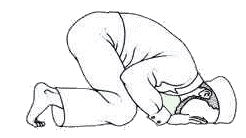1. Stops:
When reading the holy quran, we are supposed to stop (means
the reader takes a breath with the intention of continuing
reading) only when it is allowed to do so.
There are different kind of signs on top of the word to indicate
if it possible to stop or not:
 means we have to stop (The Compulsory Stop):
means we have to stop (The Compulsory Stop):
-
 we can not stop (The Prohibited Stop):
we can not stop (The Prohibited Stop):
 it is better to continue (The Good Stop):
it is better to continue (The Good Stop):
-
 it is better to stop(The Sufficient Stop):
it is better to stop(The Sufficient Stop):
-
 it is the same to stop or to continue (The Equality Stop):
it is the same to stop or to continue (The Equality Stop):
-
 if you stop one then you can not stop on the other (The
Precautionary Stop):
if you stop one then you can not stop on the other (The
Precautionary Stop):
-
 stop for a brief time:
stop for a brief time:
Note: if you lost your breath and ther is no stop sign ....example
(2-282) :
Sajda
This picture  shows
how we make sajda . shows
how we make sajda .
When reading the holy Quran we have to make sajda if we find
this sign  . .
To explain this we will look at the example below:
Now to the explanation , this sign  is to indicate that there is sajda, this sign
is to indicate that there is sajda, this sign  on top of a word explain the reason why we have to make sajda
and the last sign is
on top of a word explain the reason why we have to make sajda
and the last sign is  ,
and it shows when we make the sajda. ,
and it shows when we make the sajda.
This situation accurs 14 times in the Holy Quran:
suura 7:206, suura 13:15, suura 16:49,
suura 17:107, suura 19:58, suura 22:77,
suura 25:60, suura 27:25, suura 32:15,
suura 38:24, suura 41:37, suura 53:59,
suura 84:21, suura 96:19.
Lengthening (Madd):
Madd means lengthening of the sound .
It occurs whenever we encounter a long vowel .. and when
we encounter a "Madd" sign:  , ,
 , ,
 .
.
Practice:
- With a long vowel
- With
 we treat the letter before it as if we have the long vowel
we treat the letter before it as if we have the long vowel
 and with
and with  we treat the letter before it as if we have the long vowel
we treat the letter before it as if we have the long vowel
 .
.
- with
 The
lengthening of the sound is held for four or five, or six
counts. The example below shows how: The
lengthening of the sound is held for four or five, or six
counts. The example below shows how:
|
